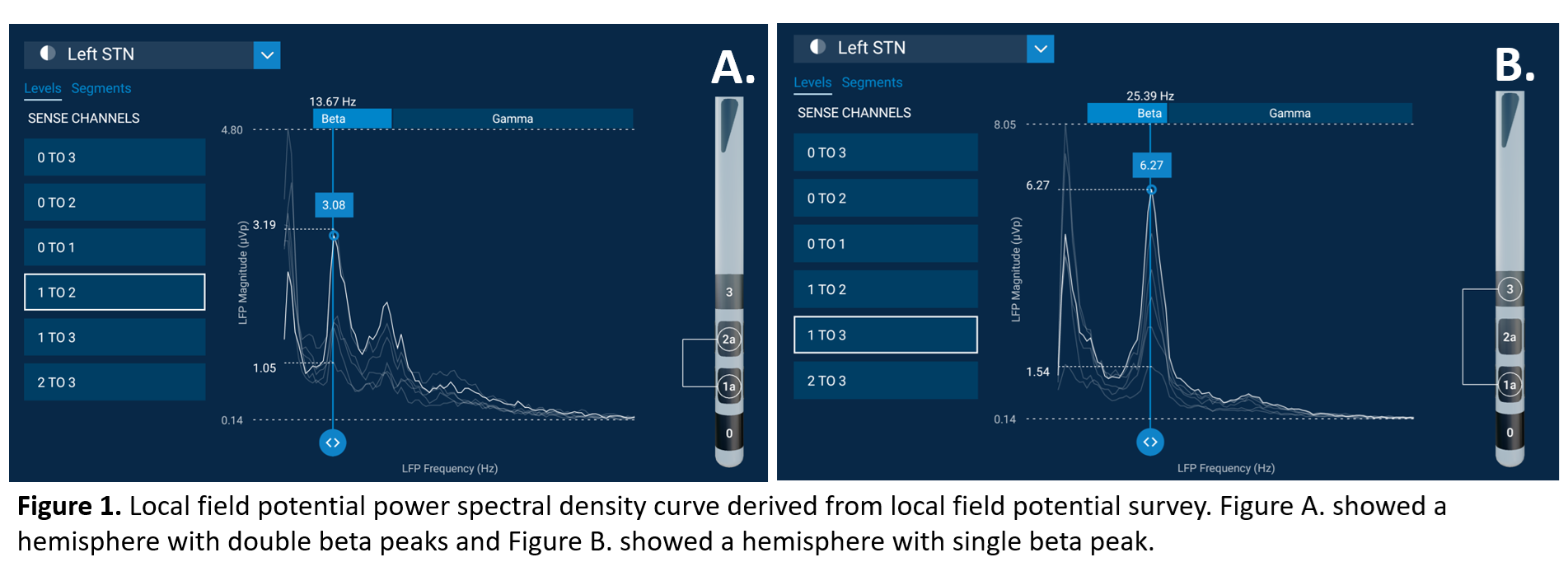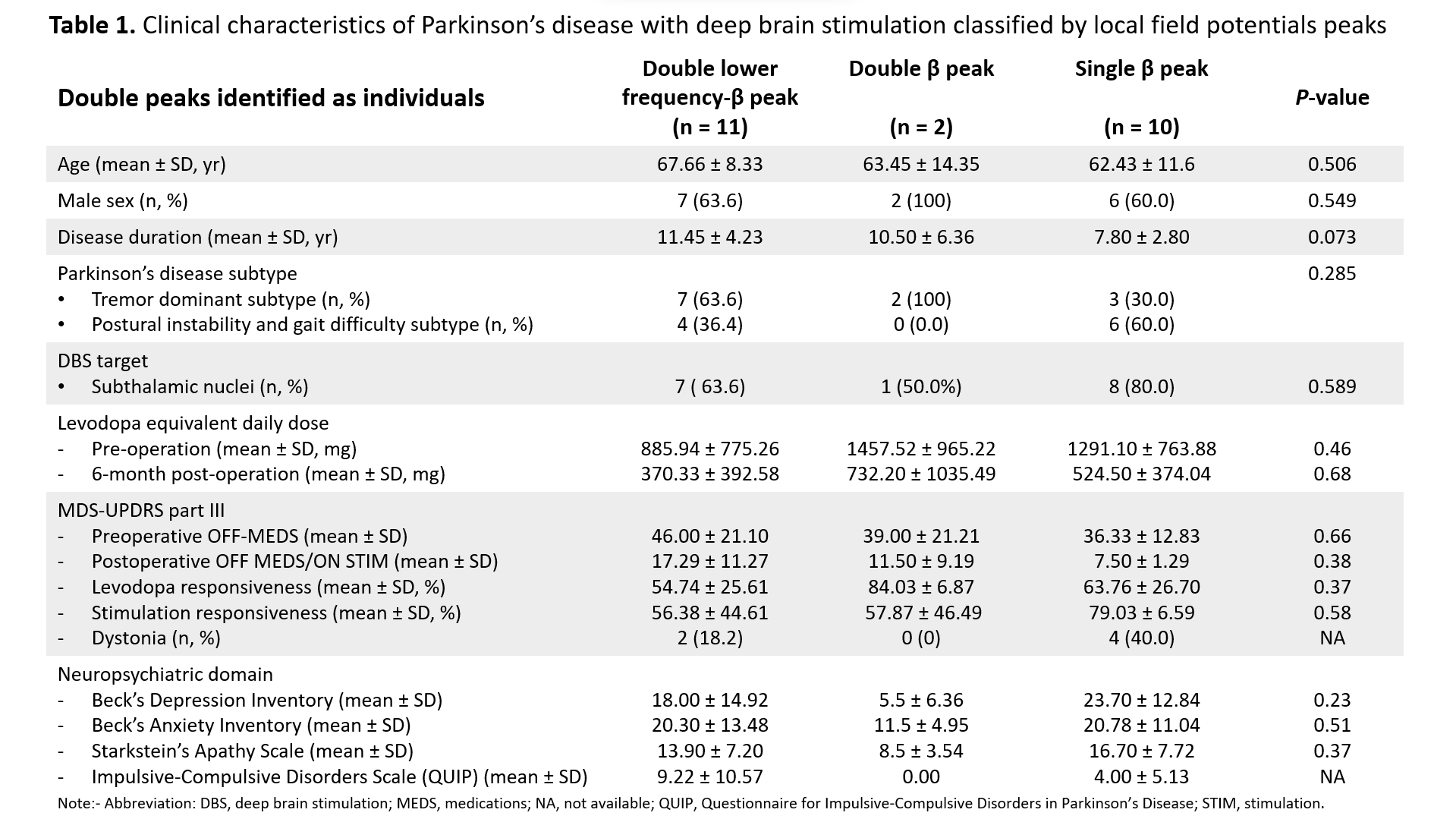Category: Surgical Therapy: Parkinson's Disease
Objective: To investigate clinical characteristics of Parkinson’s disease (PD) with deep brain stimulation, who demonstrated local field potential (LFP) with double peaks.
Background: Beta frequency oscillations (13-30 Hz) in the subthalamic nucleus are associated with akinetic-rigid symptoms in PD[1,2]. While many patients show a single oscillatory peak in the beta band (β), we have observed that some patients show double peaks, but their clinical significance is not known.
Method: We retrospectively assessed resting state OFF medication LFP power spectral density (PSD) profiles in PD patients implanted with LFP sensing-enabled DBS between June 2020 to December 2023. PSD profiles obtained by LFP survey were characterized as containing single beta (β) peak, double beta peaks (ββ) or double low-frequency-beta peaks (LF- β) (5-12 Hz), including double theta-beta peaks (Ɵβ) and double alpha-beta peaks (αβ). Pre-surgical clinical characteristics were compared between groups.
Results: Amongst 25 patients, 13 patients had double peaks: n=2 with ββ peaks, n=11 with LF- β peaks. The rest of the cohort had 10 patients with β peak and 2 patients without any peaks. PD patients with any double peaks (n=13) had significantly longer disease duration than β peak (n=10) (11.31 vs 7.6 yr, p = 0.028). PD with ββ peaks had insignificantly lower depression score compared to LP- β peaks and β peak (mean BDI 5.5 vs 18.0 vs 23.70 pts, respectively, p = 0.23). PD with LF- β peaks (n=11) had non-significantly higher depression and anxiety score compared to ββ peaks (mean BDI; 18.0 vs 5.5, p = 0.23, mean BAI; 20.3 vs 11.5, p = 0.36). The rest of motor and non-motor symptoms were comparable between groups without significant results.
Conclusion: Oscillatory activity outside the beta band can be seen in PD. Although non-significant, lower frequency range oscillatory peaks in PD may associate with non-motor symptoms such as depression or anxiety symptoms. Further studies with larger populations and to determine modulation of individual peaks with stimulation are warranted.
Figure 1
Table 1
Table 2
References: [1] Kühn AA, Tsui A, Aziz T, Ray N, Brücke C, Kupsch A, et al. Pathological synchronisation in the subthalamic nucleus of patients with Parkinson’s disease relates to both bradykinesia and rigidity. Exp Neurol. 2009;215(2):380-7. https://doi.org/10.1016/j.expneurol.2008.11.008.
[2] Chen CC, Litvak V, Gilbertson T, Kühn A, Lu CS, Lee ST, et al. Excessive synchronization of basal ganglia neurons at 20 Hz slows movement in Parkinson’s disease. Exp Neurol. 2007;205(1):214-21. https://doi.org/10.1016/j.expneurol.2007.01.027.
To cite this abstract in AMA style:
W. Saengphatrachai, S. Akkus, J. Jimenez-Shahed. Clinical Correlation of Double Oscillatory Peaks in Parkinson’s Disease with Deep Brain Stimulation [abstract]. Mov Disord. 2024; 39 (suppl 1). https://www.mdsabstracts.org/abstract/clinical-correlation-of-double-oscillatory-peaks-in-parkinsons-disease-with-deep-brain-stimulation/. Accessed January 7, 2026.« Back to 2024 International Congress
MDS Abstracts - https://www.mdsabstracts.org/abstract/clinical-correlation-of-double-oscillatory-peaks-in-parkinsons-disease-with-deep-brain-stimulation/



